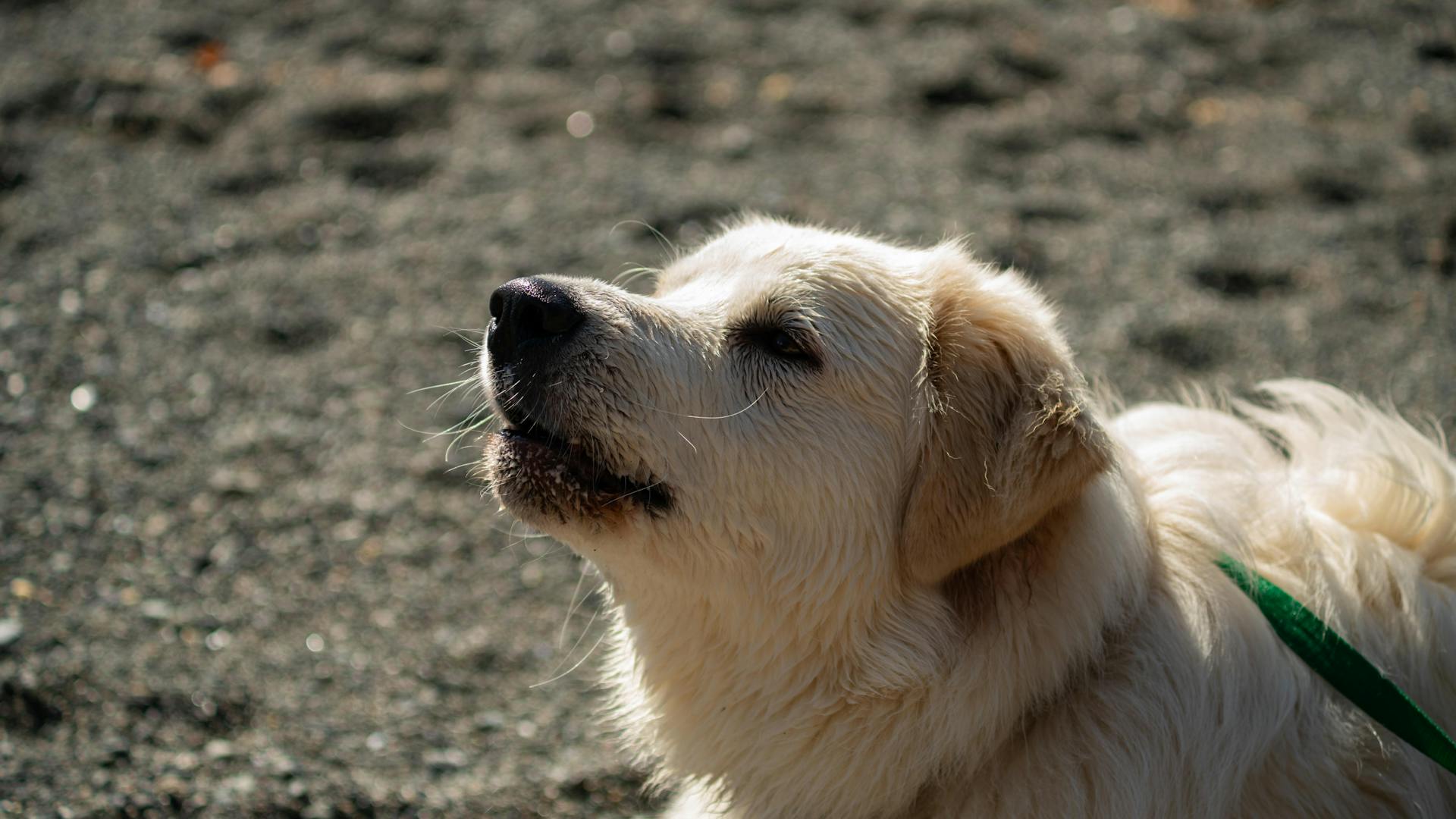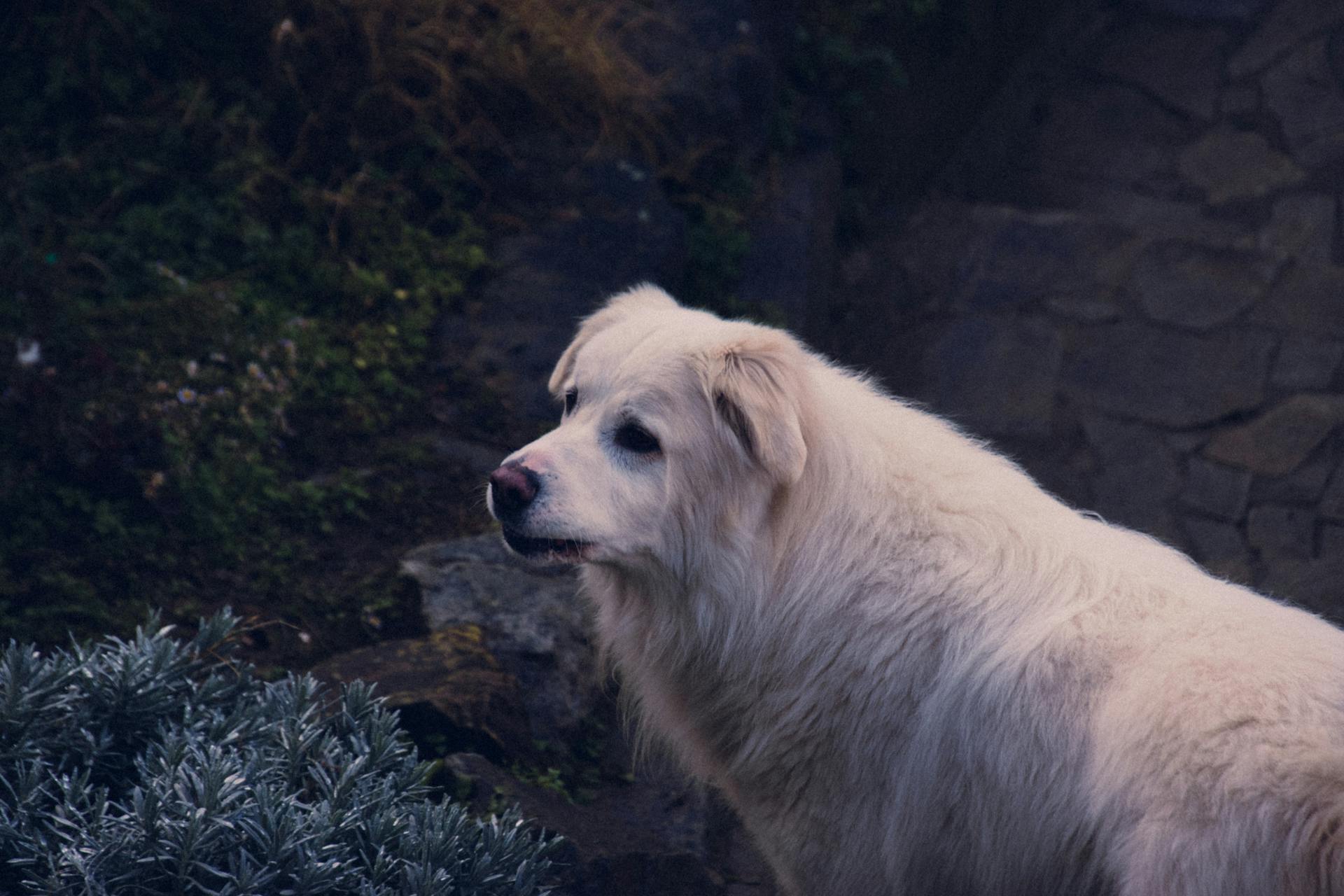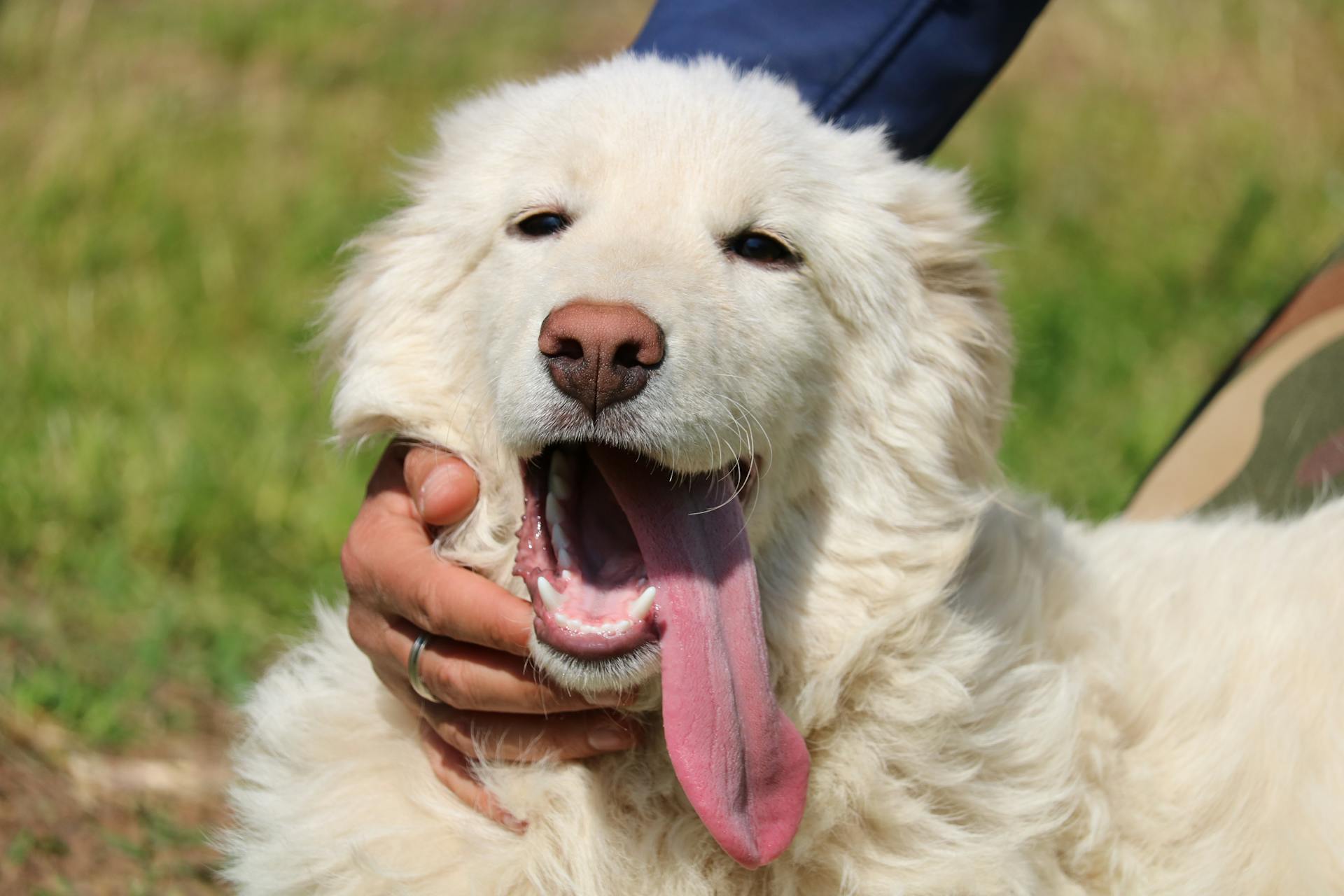
The Maremma Livestock Guardian Dog is an ancient breed from Italy, specifically from the Abruzzo region. They were originally bred to guard sheep and other livestock against predators.
These dogs are highly effective at their job due to their strong instincts and keen senses. They have a strong prey drive, which allows them to protect their flock with confidence.
Maremmas are known for their independent nature, which can sometimes make them seem aloof to new people. However, they are loyal to their family and territory.
Their thick coats and robust build make them well-suited to the harsh mountainous terrain of their native Italy.
Additional reading: Dog Names for Strong Dogs
Physical Characteristics
Maremma Sheepdogs are a large breed, with males ranging from 25.5 to 28.5 inches tall and females from 25.5 to 26.75 inches.
Their coats are thick and coarse, with a dense undercoat that sheds twice a year. This helps to repel debris and keep them warm in the winter. Regular brushing is essential to keep their coat nice and control shedding.
They have a strong build, a straight nasal canal, and a low-set tail that's thickly feathered with dense hair. Their ears are V-shaped and pointed, while their eyes have a lively, intelligent expression.
Size
Maremma Sheepdogs are a large breed, with males typically ranging from 25.5 to 28.5 inches tall.
Their height can vary slightly, with some females reaching 25.5 to 26.75 inches.
Males usually weigh between 77 to 100 pounds.
Females tend to be slightly lighter, weighing between 66 to 88 pounds.
Physical Traits
Maremma Sheepdogs are large, powerful dogs that can weigh between 77 to 100 pounds for males and 66 to 88 pounds for females.
Their size provides them with several advantages, including retaining heat longer, carrying more fat reserves, and tolerating illnesses better.
A long stride allows them to be more efficient at long distances, but they can suffer more from the heat, so they're often used in northern regions and mountain pastures.
Their dense, water-repellent coat helps to keep them warm and dry, but they do shed quite a bit, especially during seasonal changes.
Maremma Sheepdogs typically range from 25.5 to 28.5 inches tall for males and 25.5 to 26.75 inches for females, with some being smaller.
Their coat colors can vary depending on local traditions, with dogs often matching the main color of the livestock they're guarding.
You might like: Dog Fur Types
Behavior and Training
The Maremma Livestock Guardian Dog is a highly intelligent breed that requires calm, firm, and consistent leadership to listen to commands. It's essential to display mutual respect in handling and voice, and above all, consistency.
As a flock guard, the Maremma is naturally independent and alert, making it a formidable protector of its flock. However, this also means it's crucial for humans to establish themselves as pack leaders, as dogs instinctually communicate their displeasure with a growl and/or a bite.
The Maremma is a marvelous sheepdog that thrives in the snow and is resistant to cold and brambles, but it's also a terrible enemy of the wolf, making it an effective guard dog.
Suggestion: What Food Makes Dogs Sick
Personality and Work Habits
The Maremma Sheepdog is a loyal breed that thrives on independence and activity. They do best when given plenty of space to roam and engage in physical exercise.
Maremmas are naturally protective of their families and livestock, making them excellent watchdogs. However, they can be wary of strangers and may not warm up to new people quickly.
To establish a strong bond with your Maremma, it's essential to use positive reinforcement training methods. Harsh physical discipline can be counterproductive and damage your relationship with your dog.
Early socialization and training are crucial for Maremmas to adapt to your household and family dynamics. Consistency and calm, firm leadership are key to their responsiveness.
Maremmas are intelligent dogs that can be reserved with strangers, but they generally get along well with other dogs and pets. However, they may require more time to warm up to new people and animals.
In a flock or herd setting, Maremmas can take on different roles, such as following the livestock closely or patrolling the edges to keep predators at bay. Experienced ranchers and shepherds often encourage these differences to maximize the effectiveness of their dog group.
To work effectively with a Maremma, you must display calm, firm, and consistent leadership. They are bred to be independent, so it's essential to establish a strong pack leader role.
Children and Pets
Maremma Sheepdogs can make great family pets, especially if you have kids within your own family. They are known to do very well with children, but may have trouble with children outside of the family.
If you have a Maremma Sheepdog, you'll want to be mindful of their protective nature around strangers, including children who may not be part of your family.
Maremmas often get along well with other animals, especially livestock like sheep, llamas, geese, and pigs. They can even live harmoniously with cats and other dogs, including other Maremmas.
However, it's essential to ensure there's only one dominant dog in the household to avoid any potential conflicts.
On a similar theme: Maremma Italian Sheepdog
Protection and Work
At our farm, we've found the Maremma to be an exceptional livestock guardian dog, capable of guarding a variety of animals including goats, pigs, chickens, turkeys, cows, and even our many barn cats.
The Maremma's temperament is trustworthy, attentive, and protective, making them a valuable asset to our farm. They're also incredibly proficient at detecting threats from predators, primarily coyotes, and have kept our flocks and herds safe for years with zero losses.
Related reading: Great Pyrenees Working Dogs
In terms of working ethic, Maremmas are social creatures that bond with their herd, living with them and protecting them from predators. They're also independent, not needing much human instruction, and often prefer to make their own decisions regarding their herd and how they respond to threats.
We've found that having at least two Maremmas with our flock is essential, especially when dealing with large predators like bears and lions. In most cases, the Maremmas will drive off predators through a display of aggressiveness, rather than engaging in a physical fight.
Male and female Maremmas have proven to be equally effective in protecting our livestock, and we've had great success with using them to coexist with predators in our area. In fact, our large male Maremma, Gunnar, has a particular fondness for guarding our pigs.
For your interest: Bernese Mountain Dog Protecting Owner
Care and Management
Proper training early on is especially important for Maremma Sheepdogs, as it helps prevent over-exertion and the risk of hip and/or elbow dysplasia in their later years.
Maremmas need regular exercise, but shorter periods of free running or play are best while they're young to avoid putting too much strain on their joints.
They'll want to be very active when they're adults, but by then they'll be done growing, so it's not as much of a concern.
Regular dental care is crucial, so be sure to brush their teeth a few times a week or use other brushing alternatives to keep their teeth clean.
Annual vet check-ups are also essential to catch any health concerns before they become big problems.
Take a look at this: Soft Food for Dogs with No Teeth
Care
To keep your Maremma Sheepdog happy and healthy, proper training is essential. This means helping them not to over-exercise while they're young, as this can lead to hip and/or elbow dysplasia later on.
Their thick fur makes them handle cold pretty well, but they can struggle with heat, so make sure they have plenty of water and shade in the summer.

Regular dental care is crucial, such as brushing their teeth a few times a week or using alternative brushing methods.
Nail trims are also important, ideally done one or two times per month.
You should check your dog's ears regularly for irritation or debris.
Annual vet check-ups are vital to catch any health concerns before they become major problems.
Rescue Groups
Rescue Groups can be a bit tricky to find, especially for a rare breed like the Maremma Sheepdog. You can start by checking with your local shelter.
If you're having trouble finding a Maremma Sheepdog rescue group, you might consider reaching out to a rescue that caters to all kinds of dogs. They may be able to help you find a Maremma Sheepdog or a Maremma Sheepdog Mix.
One option to consider is the Maremma Sheepdog Club of America Rescue, which can provide you with more information on finding a rescue group in your area.
For more insights, see: Bernese Mountain Dog Group

You might also want to look into Blue Bonnet Animal Rescue, which could be a good starting point in your search.
Another option is to consider a rescue group dedicated to the Great Pyrenees, a close relative of the Maremma Sheepdog. Great Pyrenees Rescue Atlanta is one such group that might be able to help.
Here are some rescue groups to consider:
- Maremma Sheepdog Club of America Rescue
- Blue Bonnet Animal Rescue
- Great Pyrenees Rescue Atlanta
Breed Information
The Maremma Sheepdog is a specialist LGD breed that originated in the central Italian regions of Maremma and Abruzzo. It was developed to serve as a livestock guardian dog in the Italian countryside.
This breed has a long history that can be traced back to ancient times, and its characteristics were refined over the centuries to make it excellent at protecting herds of sheep from predators like wolves and other large carnivores.
Breed Information
The Maremma Sheepdog is an ancient breed with a rich history that dates back at least 2,000 years to ancient Roman times. They were originally bred in the central Italian regions of Maremma and Abruzzo to guard livestock from predators.
These dogs are closely related to other Eastern European livestock guarding dogs, and they all share a common ancestor, the Tibetan Mastiff. This breed has a strong instinct to protect its herd, and it's known for its independence and aloofness.
The Maremma Sheepdog has a double coat of hair, which provides excellent insulation against extreme weather. They are large dogs, capable of fighting against wolves, large cats, and even bears.
In their natural habitat, Maremmas love to spend time outdoors, as their ancestors lived and slept with the livestock outside. They are not suited for indoor living and require regular exercise and mental stimulation.
Maremmas are strong-willed and not easy to obedience train, but they make super guard dogs. They are credited with saving the Little Penguins population on an island off of Australia from invasive red foxes.
The Maremma Sheepdog is a rare breed outside of Italy, but it's gaining popularity worldwide due to its unique characteristics and abilities.
Expand your knowledge: Polish Tatra Shepherd Dog
All Purebred
Our Maremma adults are registered with the Maremma Sheepdog Club of America. This is a testament to their purebred status, which is a key characteristic of the breed.
Many breeds of LGDs are little known outside of the regions where they are still worked, and their purebred status can be a significant factor in their effectiveness as guardians.
The Maremma Sheepdog Club of America recognizes the importance of purebred breeding in maintaining the integrity and characteristics of the breed.
Broaden your view: Pembroke Welsh Corgi Breed
Comparing Livestock Guardian Breeds
Some breeds of Livestock Guardian Dogs (LGDs) are little known outside of their regions, but they display traits beneficial for guarding livestock.
Many specialist LGD breeds exist, including those that have been developed over time to excel in specific tasks.
Some of these breeds include those that are known to display traits advantageous to guarding livestock, such as a strong instinct to defend and protect.
These breeds have been developed to work effectively in different environments and situations, making them valuable assets for farmers and ranchers.
Their ability to adapt to various conditions and terrains is just one reason why they're so effective at guarding livestock.
A unique perspective: How to Stop Resource Guarding between Dogs
Frequently Asked Questions
What is the difference between Great Pyrenees and Maremma?
Great Pyrenees have a thicker coat year-round, while Maremma shed their thick winter coat as temperatures rise, with a water-resistant coat that's more suitable for warm climates
What is the most aggressive livestock guardian dog?
The Akbash is considered the most aggressive and protective breed for guarding small ruminants. Its strong instincts make it an effective guardian against predators.
How much does a Maremma Sheepdog cost?
A Maremma Sheepdog typically costs around $2150. This price may vary depending on factors such as age, breeding, and location.
What are the cons of Maremma dogs?
Maremma dogs can be prone to health issues such as elbow and hip dysplasia, which can lead to mobility problems and chronic pain. Regular veterinary check-ups and a healthy lifestyle can help mitigate these risks.
What dogs are considered LGD?
LGDs are typically Great Pyrenees, Maremma, Anatolian Shepherd, Akbash, and Komondor breeds, as well as their crosses, known for their guarding characteristics. Learn more about their unique traits and uses
Sources
- https://oldcrowefarm.com/heritage-livestock/livestock-guard-dogs/about-livestock-guard-dogs/
- https://dogtime.com/dog-breeds/maremma-sheepdog
- https://en.wikipedia.org/wiki/Livestock_guardian_dog
- https://backyardgoats.iamcountryside.com/ownership/livestock-guardian-dog-breed-comparison/
- https://www.ajshappychick.farm/maremma-sheepdogs/
Featured Images: pexels.com


